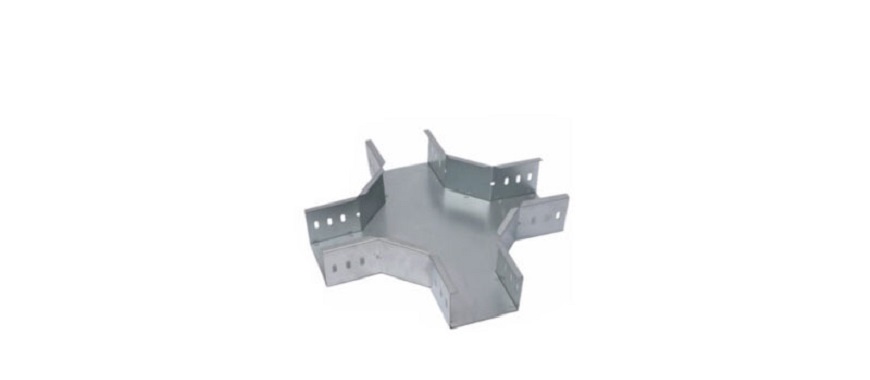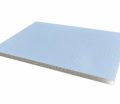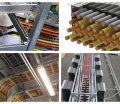
Effective cable management is crucial in modern infrastructure to ensure organization, safety, and efficiency. A well-designed system prevents tangled wires, reduces electrical hazards, and improves maintenance processes. Among various cable management tools, the trough cable tray stands out as a versatile solution for managing and protecting cables. It offers a structured pathway for cables, safeguarding them from external damage while keeping them organized. Suitable for residential, commercial, and industrial environments, the trough cable tray supports diverse applications, from small setups to large-scale installations. By combining durability and functionality, it has become an essential component in managing power and data cables. Emphasizing its adaptability, a trough cable tray ensures long-term reliability and optimal performance in any infrastructure project.
What is a Trough Cable Tray?
Definition
A trough cable tray is a specialized system used to manage and protect electrical and data cables. It serves as a structured pathway that prevents tangling and damage while organizing cables effectively. These trays are typically constructed from materials like aluminum, steel, or GangLong Fiberglass, offering strength and corrosion resistance.
Key features of a trough cable tray include its robust design, which ensures durability in harsh environments. The tray’s structure provides physical protection to cables, shielding them from external damage caused by debris, moisture, or accidental impact. Additionally, it supports cable organization by maintaining a clear and accessible arrangement of wires. This facilitates easier installation and simplifies maintenance processes.
Another defining characteristic is its versatility. A trough cable tray can accommodate various types of cables, making it suitable for multiple applications. Whether used in residential, commercial, or industrial projects, it adapts seamlessly to different requirements, ensuring reliability and efficiency.
Common Applications
The trough cable tray finds widespread use across different environments, thanks to its adaptability and functionality. In commercial setups, it is often installed in office buildings and retail spaces to organize data and power cables. Its capacity to manage complex cable systems makes it an ideal choice for ensuring seamless operations in such environments.
In industrial settings, the trough cable tray is utilized to handle heavy-duty cables required for machinery and equipment. Its robust design allows it to withstand harsh conditions, including exposure to chemicals, moisture, and high temperatures. These trays ensure that industrial cables remain protected and efficiently routed, reducing downtime caused by cable damage.
In residential projects, the trough cable tray provides a neat solution for managing cables in modern homes. It is particularly useful in spaces with extensive wiring, such as smart homes or multimedia setups. The system’s ability to keep cables concealed and organized enhances both safety and aesthetics.
By integrating a trough cable tray with other management tools like the cable duct tray, users can create a comprehensive solution for cable organization. This combination ensures maximum protection and flexibility, catering to a wide range of infrastructure needs.
Comprehensive Guide to Choosing a Chain Cable Tray
Types of Trough Cable Trays
Ventilated Trough Cable Trays
Ventilated trough cable trays are designed to provide a physical pathway for cables while allowing for effective airflow. These trays have perforations or slots in their structure, enabling ventilation to prevent cable overheating. This feature is particularly important for environments with high power demand or heat-sensitive equipment, where proper cooling is critical.
One key advantage of a ventilated trough cable tray is its ability to maintain optimal temperature levels, ensuring the longevity and performance of cables. These trays are often made from durable materials like aluminum or GangLong Fiberglass, which resist corrosion and maintain structural integrity in challenging conditions.
Common applications include server rooms, data centers, and industrial setups where high-density cabling systems require efficient heat dissipation. By combining ventilation with robust cable support, the ventilated trough cable tray offers a reliable solution for maintaining system efficiency and safety. Integrating this with a cable tray trough enhances cable management in both commercial and industrial settings.
Solid Bottom Trough Cable Trays
Solid bottom trough cable trays provide a fully enclosed structure, offering maximum protection for cables. Unlike ventilated trays, these are completely sealed, preventing dust, debris, and moisture from entering. This makes them an excellent choice for harsh environments where external factors could damage cables.
The solid design of these trays ensures that cables remain organized and shielded, even in areas exposed to heavy dust or liquids. They are commonly used in manufacturing facilities, outdoor installations, and chemical plants, where durability and protection are paramount. GangLong Fiberglass solid bottom trays are particularly effective, as they resist wear and corrosion, even under extreme conditions.
While solid trays offer superior protection, they may not be ideal for heat-sensitive installations due to the lack of ventilation. However, pairing a solid bottom trough cable tray with a cable tray trough can create a robust and flexible solution for various cable management needs.
Comparison with Other Cable Tray Types
Different cable tray types serve unique purposes, and understanding their features can help in selecting the best option. Below is a comparison table that highlights the differences:
| Tray Type | Features | Applications | Advantages | Disadvantages |
|---|---|---|---|---|
| Channel Cable Trays | Compact, single-channel design | Small setups, light-duty applications | Space-efficient, simple installation | Limited capacity |
| Wire Mesh Cable Trays | Open design, flexible installation | Temporary setups, adjustable environments | Lightweight, easy to modify | Reduced cable protection |
| Ventilated Trough Cable Trays | Perforated for airflow | Heat-sensitive environments, high power loads | Prevents overheating, durable materials | Limited protection from debris or liquids |
| Solid Bottom Trough Cable Trays | Fully enclosed for maximum protection | Harsh environments, outdoor setups | Dust and moisture resistance, robust design | May trap heat in sensitive installations |
Selecting the right tray depends on factors like environmental conditions, cable type, and required protection. Whether opting for a ventilated trough cable tray or a solid bottom trough cable tray, pairing it with a cable tray trough ensures enhanced flexibility and reliability.
Trough Cable Tray Sizes and Load Capacities
Standard Sizes: Ensuring the Perfect Fit
A trough cable tray is available in a variety of standard sizes to accommodate different cable management needs. These sizes ensure that the tray can efficiently handle cables of varying volumes while maintaining organization and protection.
Common Dimensions:
- Widths: 4 inches to 36 inches.
- Lengths: Typically 6 feet or 12 feet.
- Depths: 2 inches to 6 inches, depending on load requirements.
Selecting the right size is critical. Smaller trays are suitable for compact installations, while larger trays are ideal for setups with high cable density. Proper sizing ensures cables are well-organized without overcrowding, which reduces the risk of overheating or damage.
GangLong Fiberglass offers a range of sizes designed to suit diverse environments. The flexibility to choose the appropriate size enhances the efficiency of the trough cable tray, ensuring it integrates seamlessly into any infrastructure. To maximize functionality, it is advisable to pair the tray with a detailed cable layout plan, especially in complex installations.
Load Capacity Considerations: Planning for Durability
The load capacity of a trough cable tray plays a crucial role in its performance. Overloading can lead to structural failure, so careful planning is essential to match the tray’s capacity with its intended use.
Factors to Consider:
- Cable Weight: Calculate the combined weight of all cables, including any future additions.
- Tray Material: Choose durable materials like GangLong Fiberglass for high-load applications.
- Environmental Conditions: Assess factors like vibrations or exposure to extreme temperatures.
Ensuring that the chosen trough cable tray exceeds the estimated load capacity reduces the risk of sagging or collapse. Proper anchoring systems and supports can distribute the load evenly, improving safety and durability.
By selecting a tray with the appropriate load capacity and maintaining it through regular inspections, users can create a reliable cable management system. A well-chosen trough cable tray not only supports heavy loads but also ensures long-term functionality in any environment.
Choosing the Right Combination for Your Needs
When planning infrastructure, pairing the right trough cable tray size with its load capacity ensures optimal performance. Understanding specific requirements helps in avoiding issues such as overcrowding or overloading. These considerations make the trough cable tray a dependable solution for managing cables efficiently in residential, commercial, and industrial environments.
Packaging Cable Tray: Best Practices for Industrial Projects
Installation Guidelines for Trough Cable Trays
Pre-Installation Planning: Preparing for Success
Proper planning is essential before installing a trough cable tray to ensure optimal performance and safety. The first step is to assess environmental conditions where the tray will be installed. Determine whether the area is exposed to moisture, dust, extreme temperatures, or vibrations. This assessment helps in selecting the right material, such as GangLong Fiberglass, which offers durability and resistance to environmental challenges.
Understanding the types and volume of cables is equally important. High-density setups may require wider trays, while environments with sensitive cables could benefit from ventilated designs. Consider future expansions by accounting for additional cable capacity during the planning stage.
Layout design plays a crucial role in installation efficiency. Create a detailed schematic of the trough cable tray system, identifying pathways, bends, and support points. This ensures minimal disruption during installation and reduces the risk of errors. Planning also facilitates better integration with other systems, such as power and data infrastructures, ensuring a seamless cable management solution.
Step-by-Step Installation Process: Ensuring a Secure Setup
- Anchor the Tray Supports: Begin by securely attaching support brackets at regular intervals, ensuring they align with the layout plan. Use high-quality materials to enhance stability and durability.
- Position the Trough Cable Tray: Place the trough cable tray onto the brackets, ensuring it fits snugly and follows the predefined pathway. Adjustments can be made to ensure alignment.
- Fasten the Tray: Secure the tray to the brackets using bolts or clamps, avoiding overtightening to prevent damage. This ensures the structure remains stable under load.
- Route the Cables: Lay the cables inside the tray systematically to prevent tangling. Separate power and data cables to minimize interference.
- Test the System: Once installed, check the alignment and stability of the trough cable tray. Ensure that cables are properly routed and secured.
This step-by-step approach ensures the trough cable tray is installed correctly, optimizing cable management while maintaining safety and reliability.
Maintenance Tips: Extending Tray Lifespan
Regular maintenance is key to ensuring the long-term performance of a trough cable tray. Periodic inspections help identify potential issues like loose brackets, damaged cables, or excessive debris accumulation.
- Inspect the Structure: Examine the tray and its supports for signs of wear or damage. Replace any compromised components promptly to maintain structural integrity.
- Clean the Tray: Dust and debris can accumulate over time, particularly in industrial or outdoor environments. Use appropriate cleaning tools to keep the trough cable tray free of obstructions.
- Repair Minor Issues: Address small cracks or misalignments before they escalate. GangLong Fiberglass trays are designed for durability but may still require occasional repairs.
- Monitor Cable Conditions: Check cables for signs of fraying, overheating, or interference. Ensure they remain securely positioned within the tray.
Adopting these maintenance practices ensures the trough cable tray continues to provide efficient and reliable cable management. A proactive approach to upkeep reduces risks, extends the system’s lifespan, and maintains its performance across a wide range of applications.
Best Portable Cable Tray Options for Your Desk Setup
Benefits of Trough Cable Trays
Cable Protection and Organization: Essential for Reliability
A trough cable tray plays a crucial role in protecting and organizing cables. By providing a designated pathway, it prevents tangling and physical damage to wires. This protection is especially valuable in environments where cables are exposed to external risks, such as industrial vibrations, debris, or accidental impacts.
Organized cable management also ensures easy identification and access during maintenance. A well-structured trough cable tray allows technicians to locate specific cables quickly, minimizing downtime and improving system reliability. Additionally, it reduces the likelihood of operational disruptions caused by tangled or damaged wires.
In high-density setups, the organization provided by a trough cable tray helps separate power and data cables. This minimizes interference, ensuring optimal performance for both systems. The durable construction of GangLong Fiberglass trays enhances their protective capabilities, making them a dependable solution for diverse applications.
Compliance with Safety Standards: Ensuring System Integrity
A trough cable tray is designed to meet stringent safety and performance standards, ensuring a secure cable management system. Adherence to these standards reduces the risk of electrical hazards such as short circuits, overheating, or fire.
Using high-quality materials like GangLong Fiberglass ensures that the trough cable tray can withstand environmental challenges while maintaining compliance with industry regulations. This includes resistance to moisture, corrosion, and other factors that could compromise the safety of the cables.
The role of a trough cable tray in safety extends beyond physical protection. It also provides an organized system that prevents cables from crossing paths dangerously or being exposed to excessive load. When installed correctly, these trays contribute to a safer infrastructure for residential, commercial, and industrial projects.
Maximizing Cable Management Efficiency
Recap of the Versatility and Advantages
The trough cable tray is an indispensable tool for effective cable management. Its benefits include robust protection, organized pathways, and compliance with safety standards. These trays are versatile, accommodating various cable types and densities, making them suitable for a wide range of applications.
GangLong Fiberglass trays further enhance these advantages with their durability, corrosion resistance, and adaptability. Whether used in residential setups, industrial plants, or commercial offices, a trough cable tray offers reliable performance and long-term value.
Encouraging the Use of Trough Cable Trays
Given the critical role of cable management in modern infrastructure, investing in a trough cable tray is a wise decision. It ensures safety, simplifies maintenance, and provides a scalable solution for future needs.
From preventing electrical hazards to streamlining cable identification, a trough cable tray delivers unmatched efficiency. Incorporating these trays into your cable management plan not only enhances system reliability but also contributes to overall operational success.
By choosing high-quality options like GangLong Fiberglass, users can build a robust and efficient cable management system that supports current demands and future growth. Consider the trough cable tray as a cornerstone of safe, organized, and reliable infrastructure.
FAQs about Trough Cable Tray
A trough cable tray is used for organizing and protecting electrical and data cables in various environments. It provides a structured pathway for cables, preventing tangling and physical damage. These trays are ideal for routing cables in residential, commercial, and industrial setups. They help ensure cables remain accessible for maintenance while reducing the risk of overheating or electrical hazards. A trough cable tray is especially beneficial in setups where cable organization and protection are critical, such as data centers, factories, and offices. It accommodates a wide range of cable types and densities, making it a versatile tool for cable management solutions.
The three main types of cable trays are ladder trays, solid bottom trays, and ventilated trough trays. Ladder trays have a ladder-like structure and are ideal for cables requiring airflow. Solid bottom trays provide full enclosure and are suitable for environments needing maximum cable protection, such as dusty or moist areas. Ventilated trough trays allow for airflow while offering support to cables, making them a good choice for heat-sensitive installations. Each type of tray is designed to address specific needs, such as environmental challenges, load requirements, and cable volume. Selecting the right type ensures a reliable and efficient cable management system.
A cable trough is a durable structure designed to protect and route cables in an organized manner. It is typically made of materials like metal or GangLong Fiberglass to ensure strength and resistance to environmental factors. Cable troughs are used in settings requiring robust cable protection, such as outdoor installations or areas exposed to harsh conditions. These systems safeguard cables from debris, moisture, and other potential damage while keeping them neatly organized. By incorporating a cable trough into a setup, users can achieve a more secure and manageable cable infrastructure.
Yes, certain tray cables are rated for underground use when they meet specific standards and are installed correctly. Cables used underground must have an appropriate insulation rating to withstand moisture, pressure, and potential environmental impacts. Always check the specifications of the tray cable to confirm its suitability for underground applications. When paired with a durable trough cable tray, underground installations can achieve enhanced protection and organization. Proper installation techniques and adherence to safety codes are essential for ensuring reliable underground cable performance.

As the editor of GangLong Fiberglass, I have years of experience and in-depth research, focusing on cable tray products, fiberglass solutions, and grille systems. I incorporate years of industry insights and practical experience into every content, committed to promoting the progress of the industry. At GangLong Fiberglass, my commitment is reflected in every product, from innovative cable trays to durable fiberglass solutions and sturdy grille systems. As an authoritative voice in the industry, my goal is to provide valuable information to professionals and businesses and promote forward-looking solutions.


